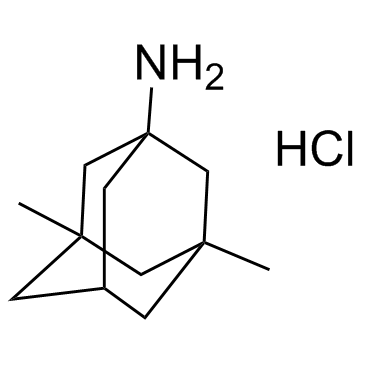memantine hydrochloride

memantine hydrochloride structure
|
Common Name | memantine hydrochloride | ||
|---|---|---|---|---|
| CAS Number | 41100-52-1 | Molecular Weight | 215.763 | |
| Density | N/A | Boiling Point | 239.8ºC at 760 mmHg | |
| Molecular Formula | C12H22ClN | Melting Point | 292 °C | |
| MSDS | USA | Flash Point | 92.3ºC | |
|
Low doses of dextromethorphan have a beneficial effect in the treatment of neuropathic pain.
Fundam. Clin. Pharmacol. 28(6) , 671-80, (2014) N-methyl-D-aspartate receptor (NMDAR) antagonists may be given in persistent neuropathic pain, but adverse events especially with ketamine may limit their clinical use. Less central and cognitive adverse events are described with dextromethorphan and memantin... |
|
|
Chemical genetics reveals a complex functional ground state of neural stem cells.
Nat. Chem. Biol. 3(5) , 268-273, (2007) The identification of self-renewing and multipotent neural stem cells (NSCs) in the mammalian brain holds promise for the treatment of neurological diseases and has yielded new insight into brain cancer. However, the complete repertoire of signaling pathways ... |
|
|
Genetic mapping of targets mediating differential chemical phenotypes in Plasmodium falciparum.
Nat. Chem. Biol. 5 , 765-71, (2009) Studies of gene function and molecular mechanisms in Plasmodium falciparum are hampered by difficulties in characterizing and measuring phenotypic differences between individual parasites. We screened seven parasite lines for differences in responses to 1,279... |
|
|
The [18F]FDG μPET readout of a brain activation model to evaluate the metabotropic glutamate receptor 2 positive allosteric modulator JNJ-42153605.
J. Pharmacol. Exp. Ther. 350(2) , 375-86, (2014) Using [(18)F]fluorodeoxyglucose μ-positron emission tomography ([(18)F]FDG μPET), we compared subanesthetic doses of memantine and ketamine on their potential to induce increases in brain activation. We also studied the reversal effect of the well-known metab... |
|
|
PBT2 inhibits glutamate-induced excitotoxicity in neurons through metal-mediated preconditioning.
Neurobiol. Dis. 81 , 176-85, (2015) Excitotoxicity is the pathological process by which neuronal death occurs as a result of excessive stimulation of receptors at the excitatory synapse such as the NMDA receptor (NMDAR). Excitotoxicity has been implicated in the acute neurological damage from i... |
|
|
Extrasynaptic glutamate NMDA receptors: key players in striatal function.
Neuropharmacology 89 , 54-63, (2014) N-methyl-D-aspartate receptors (NMDAR) are crucial for the function of excitatory neurotransmission and are present at the synapse and on the extrasynaptic membrane. The major nucleus of the basal ganglia, striatum, receives a large glutamatergic excitatory i... |
|
|
Anti-autophagic and anti-apoptotic effects of memantine in a SH-SY5Y cell model of Alzheimer's disease via mammalian target of rapamycin-dependent and -independent pathways.
Mol. Med. Report. 12 , 7615-22, (2015) Memantine non-competitively blocks the N-methyl-D-aspartate receptor in order to inhibit beta-amyloid (Aβ) secretion, and has been used to treat moderate-to-severe Alzheimer's disease (AD). However, the mechanisms underlying the role of memantine in the autop... |
|
|
Differential effects of NMDA receptor antagonists at lower and higher doses on basal gamma band oscillation power in rat cortical electroencephalograms.
Neuropharmacology 85 , 384-96, (2014) Schizophrenic patients have been shown to exhibit abnormal cortical gamma band oscillation (GBO), which is thought to be related to the symptoms of schizophrenia, including cognitive impairment. Recently, non-competitive NMDA receptor (NMDAr) antagonists such... |
|
|
Neurophysiologic and antipsychotic profiles of TASP0433864, a novel positive allosteric modulator of metabotropic glutamate 2 receptor.
J. Pharmacol. Exp. Ther. 351(3) , 642-53, (2014) Excess glutamatergic neurotransmission has been implicated in the pathophysiology of schizophrenia, and the activation of metabotropic glutamate 2 (mGlu2) receptor may exert antipsychotic effects by normalizing glutamate transmission. In the present study, we... |
|
|
Patch clamp studies on the kinetics and selectivity of N-methyl-D-aspartate receptor antagonism by memantine (1-amino-3,5-dimethyladamantan).
Neuropharmacology 32 , 1337, (1993) Memantine (1-amino-3,5-dimethyladamantan) was tested as an antagonist of N-methyl-D-aspartate (NMDA) receptors on cultured superior collicular and hippocampal neurones using the patch clamp technique and its actions were compared to those of Mg2+ ions, ketami... |